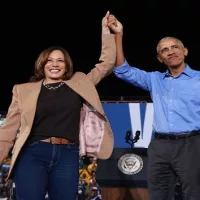
(WASHINGTON) — In her 2003 opinion upholding affirmative action in higher education, former Supreme Court Justice Sandra Day O’Connor famously predicted that in 25 years “the use of racial preferences will no longer be necessary” in America.
Next week, years after that milestone and with lingering gaps in minority college acceptance and achievement, a new group of justices will decide whether to overrule O’Connor – and more than 40 years of precedent – to declare that admissions policies must be race-blind.
“That would be a sea change in American law with huge implications across society,” said Jeffrey Rosen, president and CEO of the National Constitution Center.
In a pair of oral arguments Monday, the justices will take up race-conscious admissions policies at Harvard University, the nation’s oldest private college, and the University of North Carolina, the nation’s oldest public university.
It is the first test for affirmative action before the current court with its six-justice conservative majority and three justices of color, including the first-ever Black woman justice, Ketanji Brown Jackson.
“I think we have to be realistic in that this is a very conservative Supreme Court,” said David Lewis, a Harvard University junior and member of the school’s Black Students Association. “But this issue has been tried over and over again at the court, and the precedent has still been upheld.”
Students for Fair Admissions, a conservative and multiracial coalition of 22,000 students and parents, sued the schools in 2014 alleging intentional discrimination toward Asian American applicants in violation of the Civil Rights Act of 1964 and Equal Protection Clause of the 14th Amendment.
The group, led by longtime affirmative action critic Edward Blum, is asking the Supreme Court to outlaw consideration of race in admission to public and private colleges and universities nationwide.
“There are better ways of achieving racial diversity than treating people differently by race,” Blum, who is white, told ABC News in an interview. He argues race-neutral approaches, like a focus on socio-economic background, could meet the same objectives.
The high court has previously resisted those arguments.
In a landmark 1978 decision, a five-justice majority said that race was a permissible factor in admissions so long as a school did not use a quota system. Twenty-five years later, Justice O’Connor reaffirmed that principle in a 5-4 decision that said a school’s use of race must be narrowly-tailored. And in 2016, a similarly divided court again upheld the use of race at the University of Texas.
“Every justice on the Supreme Court and the justices that have served over the last 30 or 40 years have voted to overturn precedent,” Blum said. “It is far overdue for the Supreme Court to revisit the use of race and ethnicity in higher education, and we hope that the court will rein in that practice.”
Lower federal courts have sided with Harvard and UNC, ruling that neither broke from the Supreme Court’s long-standing precedent, which permits the limited use of race as one factor in a holistic review of individual applicants’ qualifications for admission.
“An applicant’s race is only one among dozens of factors,” UNC wrote in its brief to the high court, as admissions officers bring “together a class that is diverse along numerous dimensions — including geography, military status, and socioeconomic background.”
Harvard University argues separately that the Constitution “does not require us to disregard the commonsense reality that race is one among many things that shape life experiences in meaningful ways.”
“Nothing in the text or history of the 14th Amendment suggests that universities must uniquely exclude race from the multitude of factors considered in assembling a class of students best able to learn from each other,” the school wrote in its brief.
The 14th Amendment was drafted and ratified after the Civil War with the express purpose of extending equal rights of citizenship to former slaves and other Black Americans.
The lower courts also affirmed the schools’ “compelling interest” in pursuing educational benefits from a diverse student body and agreed that race-neutral alternatives may fall short. Blum and Students for Fair Admissions disputes those conclusions.
“In UNC’s academic judgment, diversity is central to the education it aims to provide,” the school told the court. “Ideally, UNC could achieve this diversity without consideration of race … [but it] remains necessary.”
A varied approach to race in university admissions
Since 1996, 10 states have banned the use of race in public university admissions. But roughly one-in-five U.S. public universities still consider race during the admissions process, according to a report by Ballotpedia.
“There’s something very particular about growing up in this country dealing with the ways that you were underestimated, the educational opportunities you’re denied,” said Fordham University President Tania Tetlow, the first woman to lead the Jesuit institution in its 181-year history.
“When a student comes to us having overcome all of that and succeeding,” Tetlow said, “we’re even more eager for them to be here. And the idea that we’re supposed to ignore that I just don’t understand.”
Fordham has been among the biggest defenders of affirmative action, seeing the policy as much a moral imperative as a critical tool for building a diverse campus. The undergraduate student body is 64% white, according to the school.
But not all institutions see race-conscious admissions as an imperative.
Baruch College, part of the City University of New York located in lower Manhattan, is one of the most racially diverse campuses in the country, with more than 70% students of color. The school does not consider race in admissions.
“It’s a tool to achieve the kind of campus diversity that we’re talking about, but it’s not the only tool,” said Baruch College president David Wu, the first Asian American to lead a school within the City University of New York.
Wu argues that a more effective approach is targeted recruitment in underserved communities much earlier in high school. “By the time you get into the admission policy of diversifying the student body, that’s a little bit too late,” Wu said. “Before all that happens, you need to put in the effort to build that pipeline.”
A key contrast between schools like Fordham and Baruch is cost. The private university charges roughly $56,000 a year in tuition; the public school is around $7,000 a year.
“Race has to be part of the conversation. I also think socioeconomic status is really important, and we need to find a way to talk about both of them in a nuanced way,” said Jake Moreno Coplon, CEO of America Needs You, a nonprofit that helps first-generation college students get accepted to college and navigate the transition.
“It’s hard to know what the impact of the erasure of affirmative action will do to the higher education landscape,” Coplon added.
A 2020 study of public universities that have banned affirmative action found long-term decline in black, Latino and Native American representation on those campuses – on average more than 15 percentage points lower than among state high school graduates in just the first year a ban was implemented.
At the University of California-Berkeley, which eliminated race as a factor in its admissions 1996, the admissions rate for Black students dropped from 50% to 20% in the first year and from 45% to 21% for Latinx students, according to the ACLU.
Public supports diversity but cool to affirmative action
While most Americans say they support promotion of racial diversity on college and university campuses, strong majorities also oppose the use of race as a factor in admissions decisions.
More than 60% of Americans said they would support a ban on race-based affirmative action, according to a Washington Post-Schar School poll released this month.
The views appear to be shared by majorities across racial and political groups. A Pew Research Center study earlier this year found 68% of Hispanics, 63% of Asian Americans and 59% of African Americans oppose the use of race or ethnicity in college admissions.
“There’s just talent everywhere, and if they look in the right places, they’ll find it,” said German Ortega, a Fordham University freshman and son of a Mexican immigrant from Corona, Queens, who grapples with the pros and cons of affirmative action.
Ortega is attending Fordham on a scholarship specifically earmarked for Hispanic students. “It’s sad that I got a full ride because I’m Hispanic,” Ortega said. “It’s good for me, but you know, it says a lot.”
Lewis, the Harvard junior, said minority students should never be ashamed about consideration of their race as a factor in admissions.
“Our race is not just liek a color or like a checkbox on our college applications,” Lewis said. “It tells us a whole history about what opportunities you had access to. We know how powerful systemic racism is in this country. To overcome that, and to be part of this small group of people being considered at these institutions shows that you do have incredible merit.”
Forty years of precedent on race in admissions
Affirmative Action was developed in the 1960s and 70s in part to ensure opportunity after decades of inequality and racism kept students of color on the margins of higher education.
For Baruch College in New York City, enrolling a diverse mix of students has not been difficult, but at Fordham University, Harvard, UNC and dozens of other institutions across the country, it remains a challenge.
“If the court were to follow settled precedent, our side would prevail, and we are asking the court to hold the line,” said Yasmin Cader, ACLU deputy legal director, which is backing the schools. “We are not asking or seeking advancement, just seeking that they don’t overturn efforts to achieve equality.”
Critics of affirmative action say the precedent was wrongly decided from the start and is now ripe for correction.
“A lot of the devil is going to be in the details, the scope of the rule,” said Roman Martinez, a former clerk to Chief Justice John Roberts and then-judge Brett Kavanaugh and veteran Supreme Court litigator.
If precedent is overturned, Martinez said, a key question will be what options universities will have to pursue their goals. “Will they be able to use approaches that do not explicitly take race into account but are adopted, in part, to promote diversity? There’s a lot of play in the joints,” he said.
A key figure in it all could be Justice Jackson. She recused herself from the Harvard case because of a past role on the University’s board of overseers but will fully participate in the UNC case. The court’s ultimate decision is expected to take her views and vote into account.
“I think it’s important to hear from the first black female justice on the Supreme Court of the U.S. how she feels about race consciousness in American life,” said Devon Westhill, president and general counsel at the Center for Equal Opportunity, a group that opposes race-conscious admissions. “We don’t have a good record of what her thoughts are on that.”
Copyright © 2022, ABC Audio. All rights reserved.















